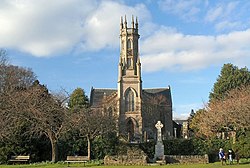Difference between revisions of "Rhu"
(Created page with "{{Infobox town |name=Rhu |county=Dunbartonshire |picture=Rhu Parish Church.jpg |picture caption=Rhu Parish Church |postcode= |latitude=56.021944 |longitude=-4.784167 |LG distr...") |
|||
| Line 15: | Line 15: | ||
Rhu stands northwest of the town of [[Helensburgh]] on the [[Firth of Clyde]]. Like many settlements along the Clyde estuary 'doon the watter' from [[Glasgow]], it became fashionable in the 19th century as a residence for wealthy Glaswegian shipowners and merchants. | Rhu stands northwest of the town of [[Helensburgh]] on the [[Firth of Clyde]]. Like many settlements along the Clyde estuary 'doon the watter' from [[Glasgow]], it became fashionable in the 19th century as a residence for wealthy Glaswegian shipowners and merchants. | ||
| − | Rhu and [[Shandon]] Parish Church dates from 1851 and stands on the site of an 18th-century predecessor. Amongst those buried in the kirkyard is Henry Bell, whose ''Comet'' was the world's first commercially successful steamship. In 1851 the marine engineer Robert Napier built the statue which today marks Bell's grave. | + | Rhu and [[Shandon, Dunbartonshire|Shandon]] Parish Church dates from 1851 and stands on the site of an 18th-century predecessor. Amongst those buried in the kirkyard is Henry Bell, whose ''Comet'' was the world's first commercially successful steamship. In 1851 the marine engineer Robert Napier built the statue which today marks Bell's grave. |
Famously a theological controversy took place in Rhu known as the "Row Heresy", involving the [[Church of Scotland]] minister John McLeod Campbell who began to teach doctrines contrary to the Westminster Confession of Faith and was subsequently expelled from his ministry in May 1831.<ref>[http://www.jstor.org/discover/10.2307/1508626?searchUri=%2Faction%2FdoBasicSearch%3FQuery%3DRow%26amp%3Bfilter%3Diid%253A10.2307%252Fi266987%26amp%3BSearch%3DSearch%26amp%3Bwc%3Don&resultItemClick=true&Search=yes&searchText=Row&uid=2134&uid=3738032&uid=2486822123&uid=2&uid=70&uid=3&uid=2486822113&uid=60&sid=21105292909573 The Rhu Heresey - JSTOR]</ref> | Famously a theological controversy took place in Rhu known as the "Row Heresy", involving the [[Church of Scotland]] minister John McLeod Campbell who began to teach doctrines contrary to the Westminster Confession of Faith and was subsequently expelled from his ministry in May 1831.<ref>[http://www.jstor.org/discover/10.2307/1508626?searchUri=%2Faction%2FdoBasicSearch%3FQuery%3DRow%26amp%3Bfilter%3Diid%253A10.2307%252Fi266987%26amp%3BSearch%3DSearch%26amp%3Bwc%3Don&resultItemClick=true&Search=yes&searchText=Row&uid=2134&uid=3738032&uid=2486822123&uid=2&uid=70&uid=3&uid=2486822113&uid=60&sid=21105292909573 The Rhu Heresey - JSTOR]</ref> | ||
Latest revision as of 12:16, 28 February 2021
| Rhu | |
| Dunbartonshire | |
|---|---|
 Rhu Parish Church | |
| Location | |
| Location: | 56°1’19"N, 4°47’3"W |
| Data | |
| Local Government | |
| Council: | Argyll and Bute |
Rhu is a village on the east shore of the Gare Loch in Dunbartonshire.
The traditional spelling of its name was Row, but it was changed in the 1920s so that outsiders would pronounce it correctly. The name derives from the Scots Gaelic, in which language the village name is An Rubha, menaing 'The Point'
Rhu stands northwest of the town of Helensburgh on the Firth of Clyde. Like many settlements along the Clyde estuary 'doon the watter' from Glasgow, it became fashionable in the 19th century as a residence for wealthy Glaswegian shipowners and merchants.
Rhu and Shandon Parish Church dates from 1851 and stands on the site of an 18th-century predecessor. Amongst those buried in the kirkyard is Henry Bell, whose Comet was the world's first commercially successful steamship. In 1851 the marine engineer Robert Napier built the statue which today marks Bell's grave.
Famously a theological controversy took place in Rhu known as the "Row Heresy", involving the Church of Scotland minister John McLeod Campbell who began to teach doctrines contrary to the Westminster Confession of Faith and was subsequently expelled from his ministry in May 1831.[1]
Sport
Rhu is a base for yachting. It includes a point, just opposite another point near Rosneath, which forms what is known as either the "Rhu Narrows" or the "Rosneath Narrows" at the mouth of the Gare Loch. The loch would have been cut off and a lagoon formed if the longshore drift were allowed to occur naturally. Groynes prevent this from happening.
Rhu Amateur Football Club have been in existence since 1896, they played Garelochead on January 1 that year.
Outside links
| ("Wikimedia Commons" has material about Rhu) |